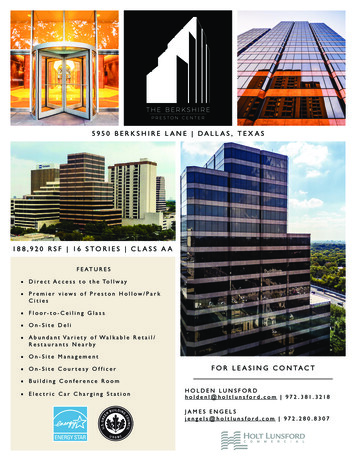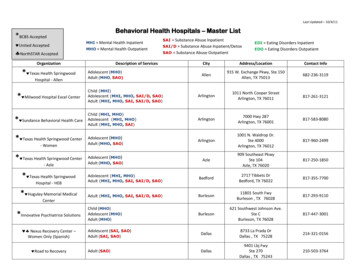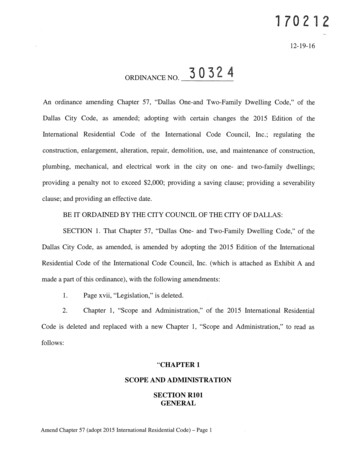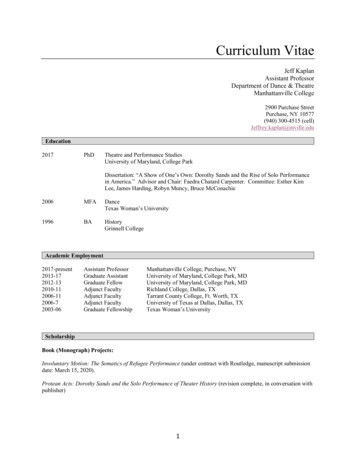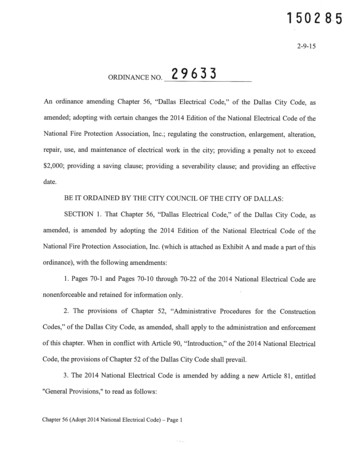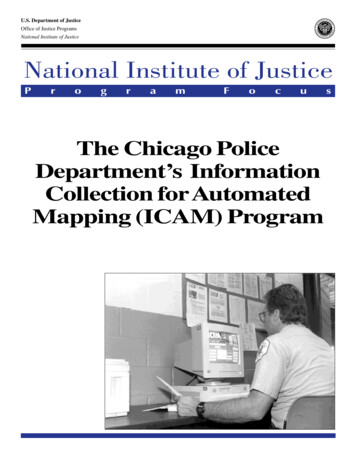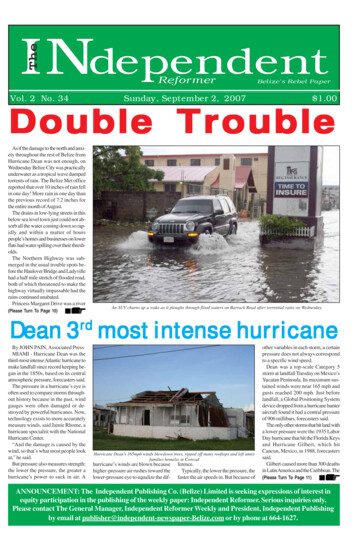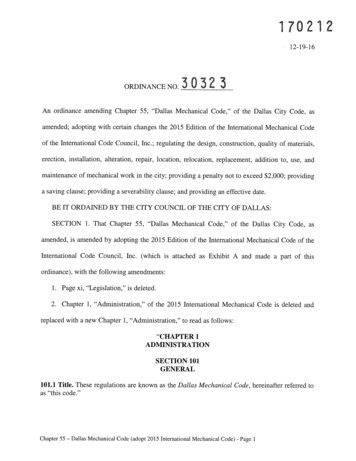
Transcription
17021212-19-163032 3An ordinance amending Chapter 55, “Dallas Mechanical Code,” of the Dallas City Code, asamended; adopting with certain changes the 2015 Edition of the International Mechanical Codeof the International Code Council, Inc.; regulating the design, construction, quality of materials,erection, installation, alteration, repair, location, relocation, replacement, addition to, use, andmaintenance of mechanical work in the city; providing a penalty not to exceed 2,000; providinga saving clause; providing a severability clause; and providing an effective date.BE IT ORDMNED BY THE CITY COUNCIL OF THE CITY OF DALLAS:SECTION 1. That Chapter 55, “Dallas Mechanical Code,” of the Dallas City Code, asamended, is amended by adopting the 2015 Edition of the International Mechanical Code of theInternational Code Council, Inc. (which is attached as Exhibit A and made a part of thisordinance), with the following amendments:1. Page xi, “Legislation,” is deleted.2. Chapter 1, “Administration,” of the 2015 International Mechanical Code is deleted andreplaced with a new Chapter 1, “Administration,” to read as follows:“CHAPTER 1ADMINISTRATIONSECTION 101GENERAL101.1 Title. These regulations are known as the Dallas Mechanical Code, hereinafter referred toas “this code.”Chapter 55—Dallas Mechanical Code (adopt 2015 International Mechanical Code) Page 1-
30323170212101.2 Scope. This code regulates the design, installation, maintenance, alteration and inspectionof mechanical systems that are permanently installed and utilized to provide control ofenvironmental conditions and related processes within buildings. This code also regulates thosemechanical systems, system components, equipment and appliances specifically addressedherein. The installation of fuel gas distribution piping and equipment, fuel gas-fired appliancesand fuel gas-fired appliance venting systems are regulated by the Dallas Fuel Gas Code.Exceptions:1. Detached one- and two-family dwellings and multiple single-family dwellings(townhouses) not more than three stories high with separate means of egress and theiraccessory structures must comply with the Dallas One- and Two-Family DwellingCode.2. Mechanical systems in existing buildings undergoing repair, alterations, or additions,and change of occupancy may comply with the Dallas Existing Building Code.101.3 Administrative procedures. Except as otherwise specified in this code, all provisions ofChapter 52, “Administrative Procedures for the Construction Codes,” of the Dallas City Codeapply to this code.101.4 Referenced codes and standards. The codes and standards referenced in this code areconsidered part of the requirements of this code to the prescribed extent of each such referenceonly when such codes and standards have been specifically adopted by the city of Dallas.Whenever amendments have been adopted to the referenced codes and standards, each referenceto the codes and standards is considered to reference the amendments as well. Any referencemade to NFPA 70 or the ICC Electrical Code means the Dallas Electrical Code, as amended.References made to the International Plumbing Code, the International Building Code, theInternational Fire Code, the International Energy Conservation Code, the International FuelGas Code, the International Existing Building Code, and the International Residential Code,respectively mean the Dallas Plumbing Code, the Dallas Building Code, the Dallas Fire Code,the Dallas Energy Conservation Code, the Dallas Fuel Gas Code, the Dallas Existing BuildingCode, and the Dallas One- and Two-Family Dwelling Code, as amended.Exception: Where enforcement of a code provision would violate the conditions of thelisting of the equipment or appliance, the conditions of the listing and the manufacturer’sinstructions apply.”The definition of “Environmental Air,” in Section 202, “General Definitions,” of3.Chapter 2, “Definitions,” of the 2015 International Mechanical Code is amended to read asfollows:“ENVIRONMENTAL AIR. Air that is conveyed to or from occupied areas through ductswhich are not part of the heating or air-conditioning system, such as ventilation for human usage,Chapter 55—Dallas Mechanical Code (adopt 2015 International Mechanical Code) Page 2-
30323170212domestic kitchen range exhaust, bathroom exhaust, domestic clothes dryer exhaust [and parkinggarage exhaust].”4.Subsection 304.3, “Elevation of Ignition Source,” of Section 304, “Installation,”of Chapter 3, “General Regulations,” of the 2015 International Mechanical Code is amended toread as follows:“304.3 Elevation of ignition source. Equipment and appliances having an ignition source andlocated in hazardous locations and public garages, private garages, repair garages, automotivemotor fuel-dispensing facilities and parking garages shall be elevated such that the source ofignition is not less than 18 inches (457 mm) above the floor surface on which the equipment orappliance rests. For the purpose of this section, rooms or spaces that are not part of the livingspace of a dwelling unit and that communicate directly with a private garage through openingsshall be considered to be part of the private garage.Exceptions:1. Elevation of the ignition source is not required for appliances that are listed asflammable vapor ignition resistant.Electric appliances.304.3.1 Parking garages. Connection of a parking garage with any room in which there is afuel-fired appliance shall be by means of a vestibule providing a two-doorway separation,except that a single door is permitted where the sources of ignition in the appliance areelevated in accordance with Section 304.3.Exception: This section shall not apply to appliance installations complying with Section304.6.”5.Subsection 304.7, “Private Garages,” of Section 304, “Installation,” of Chapter 3,“General Regulations,” of the 2015 International Mechanical Code is deleted.6.Subsection 306.3, “Appliances in Attics,” of Section 306, “Access and ServiceSpace,” of Chapter 3, “General Regulations,” of the 2015 International Mechanical Code isamended to read as follows:“306.3 Appliances in attics. Attics containing appliances requiring access shall be providedwith an opening and unobstructed passageway large enough to allow removal of the largestappliance. The passageway shall not be less than 30 inches (762 mm) high and 22 inches (559mm) wide and not more than 20 feet (6096 mm) in length measured along the centerline of theChapter 55—Dallas Mechanical Code (adopt 2015 International Mechanical Code) Page 3-
30323170212passageway from the opening to the ‘appliance. The passageway shall have continuous solidflooring not less than 24 inches (610 mm) wide. A level service space not less than 30 inches(762 mm) deep and 30 inches (762 mm) wide shall be present at the front or service side of theappliance. The clear access opening dimensions shall be not less than 20 inches by 30 inches(508 mm by 762 mm) or larger where such dimensions are not[, and] large enough to allowremoval of the largest appliance. A walkway to an appliance must be rated as a floor asapproved by the building official. At a minimum, one of the following must be provided foraccess to the attic space:1. A permanent stair.1 A pull down stair with a minimum 300 lb (136 kg’) capacity.3. An access door from an upper floor level.Due to structural conditions, an access panel may be used in lieu of items 1, 2 or 3 with the priorapproval of the building official.Exceptions:1. The passageway and level service space are not required where the appliance iscapable of being serviced and removed through the required opening.2. Where the passageway is unobstructed and not less than 6 feet (1829 mm) high and22 inches (559 mm) wide for its entire length, the passageway shall be not greaterthan 50 feet (15 250 mm) in length.306.3.1 Electrical requirements. A luminaire controlled by a switch located at the requiredpassageway opening and a receptacle outlet shall be provided at or near the appliancelocation in accordance with the Dallas Electric Code. Low voltage wiring of 50 volts or lessmust be installed in an approved manner as defined in the Dallas Electrical Code in order toprevent physical damage to the wiring [NFPA-7-0].”Subsection 306.5, “Equipment and Appliances on Roofs or Elevated Structures,”7.of Section 306, “Access and Service Space,” of Chapter 3, “General Regulations,” of the 2015International Mechanical Code is amended to read as follows:“306.5 Equipment and appliances on roofs or elevated structures. Where equipmentrequiring access or appliances are located on an elevated structure or the roof of a building suchthat personnel will have to climb higher than 16 feet (4877 mm) above grade to access apermanent [such equipment or appliances, an] interior or exterior means of access shall beprovided. Permanent exterior ladders providing roof access need not extend closer than 12 feet(2438 mm) to the finish grade or floor level below and must extend to the equipment andappliances’ level service space. Such access shall not require climbing over obstructions greaterthan 30 inches (762 mm) in height or walking on roofs having a slope greater than 4 unitsChapter 55—Dallas Mechanical Code (adopt 2015 International Mechanical Code) Page 4-
30323170212vertical in 12 units horizontal (33-percent slope). Such access shall not require the use ofportable ladders. Where access involves climbing over parapet walls, the height shall bemeasured to the top of the parapet wall.Permanent ladders installed to provide the required access shall comply with the followingminimum design criteria:1. The side railing shall extend above the parapet or roof edge not less than 30 inches (762mm).2. Ladders shall have rung spacing not to exceed 14 inches (356 mm) on center. Theuppermost rung shall be not greater than 24 inches (610 mm) below the upper edge of theroof hatch, roof or parapet, as applicable.3. Ladders shall have a toe spacing not less than 6 inches (152 mm) deep.4. There shall be not less than 18 inches (457 mm) between rails.5. Rungs shall have a minimum 0.75-inch (19 mm) diameter and be capable of withstandinga 300-pound (136.1 kg) load.6. Ladders over 30 feet (9144 mm) in height shall be provided with offset sections andlandings capable of withstanding 100 pounds per square foot (488.2 kg/rn). Landing2dimensions shall be not less than 18 inches (457 mm) and not less than the width of theladder served. A guard rail shall be provided on all open sides of the landing.7. Climbing clearance. The distance from the centerline on the rungs to the nearestpermanent object on the climbing side of the ladder shall be not less than 30 inches (762mm) measured perpendicular to the rungs. This distance shall be maintained from thepoint of ladder access to the bottom of the roof hatch. A minimum clear width of 15inches (381 mm) shall be provided on both sides of the ladder measured from midpoint ofand parallel with the rungs except where cages or wells are installed.8. Landing required. The ladder shall be provided with a clear and unobstructed bottomlanding area having a minimum dimension of 30 inches (762 mm) by 30 inches (762mm) centered in front of the ladder.9. Ladders shall be protected against corrosion by approved means.10. Access to ladders shall be provided at all times.Catwalks installed to provide the required access shall be not less than 24 inches (610 mm)wide and shall have railings as required for service platforms.Exception: This section shall not apply to Group R-3 occupancies.Chapter 55—Dallas Mechanical Code (adopt 2015 International Mechanical Code) Page 5-
30323170212306.5.1 Sloped roofs. Where appliances, equipment, fans or other components that requireservice are installed on [] roofs having [] slopes greater than four [of three] units vertical in12 units horizontal (33[4]-percent slope) [or greater] and having an edge more than 30inches (762 mm) above grade at such edge, a catwalk at least 16 inches (406.4 mm) in widthwith substantial cleats spaced not more than 16 inches (406.4 mm) apart must be providedfrom the roof access to a level platform at the appliance. The level platform shall be providedon each side of the appliance or equipment to which access is required for service, repair ormaintenance. The platform shall be not less than 30 inches (762 mm) in any dimension andshall be provided with guards. The guards shall extend not less than 42 inches (1067 mm)above the platform, shall be constructed so as to prevent the passage of a 21-inch diameter(533 mm) sphere and shall comply with the loading requirements for guards specified in theDallas [International] Building Code. Access shall not require walking on roofs having aslope greater than four units vertical in 12 units horizontal (33-percent slope). Where accessinvolves obstructions greater than 30 inches (762 mm) in height, such obstructions shall beprovided with ladders installed in accordance with Section 306.5 or stairways installed inaccordance with the requirements specified in the Dallas [International] Building Code in thepath of travel to and from appliances, fans or equipment requiring service.306.5.2 Electrical requirements. A receptacle outlet shall be provided at or near theequipment location in accordance with the Dallas Electrical Code [NFPA 70].”8.Section 306, “Access and Service Space,” of Chapter 3, “General Regulations,” ofthe 2015 International Mechanical Code is amended by adding a new Subsection 306.6, “WaterHeaters Above Ground or Floor,” to read as follows:“306.6 Water heaters above ground or floor. When the attic, roof, mezzanine or platform inwhich a water heater is installed is more than 8 feet (2438 mm) above the ground or floor level, itmust be made accessible by a stairway or permanent ladder fastened to the building.Exception: A water heater may be reached by portable ladder if the water heater has acapacity of no more than 10 gallons (or larger with prior approval), it is capable of beingaccessed through a lay-in ceiling, and it is installed not more than 10 feet (3048 mm) abovethe ground or floor level.306.6.1. Illumination and convenience outlet. Whenever the attic, roof, mezzanine orplatform is not adequately lighted or access to a receptacle outlet is not obtainable from themain level, lighting and a receptacle outlet must be provided in accordance with Section306.3.1.”Subsection 307.2, “Evaporators and Cooling Coils,” of Section 307, “Condensate9.Disposal,” of Chapter 3, “General Regulations,” of the 2015 International Mechanical Code isamended to read as follows:Chapter 55—Dallas Mechanical Code (adopt 2015 International Mechanical Code) Page 6-
30323170212“307.2 Evaporators and cooling coils. Condensate drain systems shall be provided forequipment and appliances containing evaporators or cooling coils. Condensate drain systemsshall be designed, constructed and installed in accordance with Sections 307.2.1 through 307.2.5.Exception: Evaporators and cooling coils that are designed to operate in sensible coolingonly and not support condensation shall not be required to meet the requirements of thissection.307.2.1 Condensate disposal. Condensate from all cooling coils and evaporators shall beconveyed from the drain pan [outlet] to an approved place of disposal. Such piping shallmaintain a minimum horizontal slope in the direction of discharge of not less than one-eighthunit vertical in 12 units horizontal (1-percent slope). Condensate shall not discharge into astreet, alley, sidewalk, rooftop or other areas so as to cause a nuisance.307.2.2 Drain pipe materials and sizes. Components of the condensate disposal systemshall be cast iron, galvanized steel, copper, cross-linked polyethylene, polyethylene, ABS,CPVC, PVC, or polypropylene pipe or tubing. When exposed to ultra violet light, schedule80 PVC pipe or tubing is required. Components shall be selected for the pressure [an4]temperature, and exposure rating of the installation. Joints and connections shall be made inaccordance with the applicable provisions of Chapter 7 of the Dallas [International]Plumbing Code relative to the material type. Condensate waste and drain line size shall be%-inch (19.1 mm) internal diameter and shall not decrease in size from the drainnot less than 3pan connection to the place of condensate disposal. Where the drain pipes from more thanone unit are manifolded together for condensate drainage, the pipe or tubing shall be sized inaccordance with Table 307.2.2.307.2.3 Auxiliary and secondary drain systems. In addition to the requirements of Section307.2.1, where damage to any building components could occur as a result of overflow fromthe equipment primary condensate removal system, one of the following auxiliary protectionmethods shall be provided for each cooling coil or fuel-fired appliance that producescondensate:1. An auxiliary drain pan with a separate drain shall be provided under the coils onwhich condensation will occur. The auxiliary pan drain shall discharge to aconspicuous point of disposal to alert occupants in the event of a stoppage of theprimary drain. The pan shall have a minimum depth of 1 ½ inches (38 mm), shall notbe less than 3 inches (76 mm) larger than the unit, or the coil dimensions in width andlength and shall be constructed of corrosion-resistant material. Galvanized sheet steelpans shall have a minimum thickness of not less than 0.0236 inch (0.60 10 mm) (No.24 gage). Nonmetallic pans shall have a minimum thickness of not less than 0.0625inch (1.6 mm).2. A separate overflow drain line shall be connected to the drain pan provided with theequipment. Such overflow drain shall discharge to a conspicuous point of disposal toalert occupants in the event of a stoppage of the primary drain. The overflow drainline shall connect to the drain pan at a higher level than the primary drain connection.Chapter 55—Dallas Mechanical Code (adopt 2015 International Mechanical Code) Page 7-
17021230323However, the conspicuous point must not create a hazard such as dripping over astreet, alley, sidewalk, rooftop or other areas so as to create a nuisance.3. An auxiliary drain pan without a separate drain line shall be provided under the coilson which condensate will occur. Such pan shall be equipped with a water-leveldetection device conforming to UL 508 that will shut off the equipment served priorto overflow of the pan. The auxiliary drain pan shall be constructed in accordancewith Item 1 of this section. A water level detection device may be installed only withprior approval of the building official.4. A water level detection device conforming to UL 508 shall be provided that will shutoff the equipment served in the event that the primary drain is blocked. The deviceshall be installed in the primary drain line, the overflow drain line, or in theequipment-supplied drain pan, located at a point higher than the primary drain lineconnection and below the overflow rim of such pan. A water level detection devicemay be installed only with prior approval of the building official.Exception: Fuel-fired appliances that automatically shut down operation in the event ofa stoppage in the condensate drainage system.307.2.3.1 Water-level monitoring devices. On down-flow units and all other coils thatdo not have a secondary drain or provisions to install a secondary or auxiliary drain pan,a water-level monitoring device shall be installed inside the primary drain pan. Thisdevice shall shut off the equipment served in the event that the primary drain becomesrestricted. Devices installed in the drain line shall not be permitted. A water leveldetection device may be installed only with prior approval of the building official.307.2.3.2 Appliances, equipment and insulation in pans.Where appliances,equipment or insulation are subject to water damage when auxiliary drain pans fill, thatportion of the appliance, equipment and insulation shall be installed above the rim of thepan. Supports located inside of the pan to support the appliance or equipment shall bewater resistant and approved.307.2.4 Traps. Condensate drains shall be trapped as required by the equipment orappliance manufacturer.307.2.4.1 Ductless mini-split system traps. Ductless mini-split equipment that producescondensate shall be provided with an inline check valve located in the drain line, or atrap.307.2.5 Drain line maintenance. Condensate drain lines shall be configured to permitthe clearing of blockages and performance of maintenance without requiring the drainline to be cut.Chapter 55—Dallas Mechanical Code (adopt 2015 International Mechanical Code) Page 8-
1702123032310.Paragraph 403.2.1, “Recirculation of Air,” of Subsection 403.2, “Outdoor AirRequired,” of Section 403, “Mechanical Ventilation,” of Chapter 4, “Ventilation,” of the 2015International Mechanical Code is amended to read as follows:“403.2.1 Recirculation of air. The outdoor air required by Section 403.3 shall not berecirculated. Air in excess of that required by Section 403.3 shall not be prohibited frombeing recirculated as a component of supply air to building spaces, except that:1. Ventilation air shall not be recirculated from one dwelling to another or to dissimilaroccupancies.2. Supply air to a swimming pool and associated deck areas shall not be recirculatedunless such air is dehumidified to maintain the relative humidity of the area at 60percent or less. Air from this area shall not be recirculated to other spaces wheremore than 10 percent of the resulting supply airstream consists of air recirculatedfrom these spaces.3. Where mechanical exhaust is required by Note b in Table 403.3.1.1, recirculation ofair from such spaces shall be prohibited. Recirculation of air that is containedcompletely within such spaces shall not be prohibited. Where recirculation of air isprohibited, all air supplied to such spaces shall be exhausted, including any air inexcess of that required by Table 403.3.1.1.4. Where mechanical exhaust is required by Note g in Table 403.3.1.1, mechanicalexhaust is required and recirculation from such spaces is prohibited where more than10 percent of the resulting supply airstream consists of air recirculated from thesespaces. Recirculation of air that is contained completely within such spaces shall notbe prohibited.Toilet rooms within private dwellings that contain only a water closet, lavatory orcombination thereof may be ventilated with an approved mechanical recirculating fanor similar device designed to remove odors from the air.”11.Subsection 501.3, “Exhaust Discharge,” of Section 501, “General,” of Chapter 5,“Exhaust Systems,” of the 2015 International Mechanical Code is amended to read as follows:“501.3 Exhaust discharge. The air removed by every mechanical exhaust system shall bedischarged outdoors at a point where it will not cause a public nuisance and not less than thedistances specified in Section 501.3.1. The air shall be discharged to a location from which itcannot again be readily drawn in by a ventilating system. Air shall not be exhausted into an attic,crawl space, or be directed onto walkways.Exceptions:Chapter 55—Dallas Mechanical Code (adopt 2015 International Mechanical Code) Page 9-
3032317021.21. Whole-house ventilation-type attic fans shall be permitted to discharge into the atticspace of dwelling units having private attics.2. Commercial cooking recirculating systems.3. Where installed in accordance with the manufacturer’s instructions and wheremechanical or natural ventilation is otherwise provided in accordance with Chapter 4,listed and labeled domestic ductless range hoods shall not be required to discharge tothe outdoors.4. Toilet room exhaust ducts may terminate in a warehouse or shop area wheninfiltration of outside air is present.501.3.1 Location of exhaust outlets. The termination point of exhaust outlets and ductsdischarging to the outdoors shall be located with the following minimum distances:1. For ducts conveying explosive or flammable vapors, fumes or dusts: 30 feet (9144mm) from property lines; 10 feet (3048 mm) from operable openings into buildings; 6feet (1829 mm) from exterior walls and roofs; 30 feet (9144 mm) from combustiblewalls and operable openings into buildings which are in the direction of the exhaustdischarge; 10 feet (3048 mm) above adjoining grade.2. For other product-conveying outlets, including but not limited to enclosed parkinggarage, loading dock, and motor vehicle repair garage exhaust outlets: 10 feet (3048mm) from the property lines; 3 feet (914 mm) from exterior walls and roofs; 10 feet(3048 mm) from operable openings into buildings; 10 feet (3048 mm) aboveadjoining grade.3. For all environmental air exhaust: 3 feet (914 mm) from property lines; 3 feet (914mm) from operable openings into buildings for all occupancies other than Group U,and 10 feet (3048 mm) from mechanical air intakes. Such exhaust shall not beconsidered hazardous or noxious.4. Exhaust outlets serving structures in flood hazard areas shall be installed at or abovethe elevation required by Section 1612 of the Dallas [International] Building Codefor utilities and attendant equipment.For specific systems see the following sections:5.Chapter 55—5.1.Clothes dryer exhaust, Section 504.4.5.2.Kitchen hoods and other kitchen exhaust equipment, Section 506.3.13, 506.4and 506.5.5.3.Dust stock and refuse conveying systems, Section 511.2.Dallas Mechanical Code (adopt 2015 International Mechanical Code) Page 10-
303235.4.Subsiab soil exhaust systems, Section 512.4.5.5.Smoke control systems, Section 5 13.10.3.5.6.Refrigerant discharge, Section 1105.7.5.7.Machinery room discharge, Section 1105.6.1.170212501.3.2 Exhaust opening protection. Exhaust openings that terminate outdoors shall beprotected with corrosion-resistant screens, louvers or grilles. Openings in screens, louversand grills shall be sized not less than ‘/4 inch (6.4 mm) and not larger than ½ inch (12.7 mm).Openings shall be protected against local weather conditions. Louvers that protect exhaustopenings in structures located in hurricane-prone regions, as defined in the Dallas[Intcl7iatiolzal] Building Code, shall comply with AMCA Standard 550. Outdoor openingslocated in exterior walls shall meet the provisions for exterior wall opening protectives inaccordance with the Dallas [hiternational] Building Code.”12.Paragraph 504.8.2, “Duct Installation,” of Subsection 504.8, “Domestic ClothesDryer Ducts,” of Section 504, “Clothes Dryer Exhaust,” of Chapter 5, “Exhaust Systems,” of the2015 International Mechanical Code is amended to read as follows:“504.8.2 Duct installation. Exhaust ducts shall be supported at 4-foot (1219 mm) intervalsand secured in place. The insert end of the duct shall extend into the adjoining duct or fittingin the direction of airflow. Ducts shall not be joined with screws or similar fasteners [thprotrude more than 1/8 inch (3.2 mm) into the inside of the duct].”13.Subsection 505.1, “Domestic Systems,” of Section 505, “Domestic KitchenExhaust Equipment,” of Chapter 5, “Exhaust Systems,” of the 2015 International MechanicalCode is amended to read as follows:“505.1 Domestic systems. Where domestic range hoods and domestic appliances equipped withdowndraft exhaust are provided within dwelling units, such hoods and appliances shall dischargeto the outdoors through sheet metal ducts constructed of galvanized steel, stainless steel,aluminum or copper. Such ducts shall have smooth inner walls, shall be air tight, shall beequipped with a backdraft damper, and shall be independent of all other exhaust systems.Exceptions:1. [In other than Group I 1 and I 2,] W[w]here installed in accordance with themanufacturer’s instructions and where mechanical or natural ventilation is otherwiseprovided in accordance with Chapter 4, listed and labeled ductless range hoods shallnot be required to discharge to the outdoors.Chapter 55—Dallas Mechanical Code (adopt 2015 International Mechanical Code) Page 11-
170212303232. Ducts for domestic kitchen cooking appliances equipped with downdraft exhaustsystems shall be permitted to be constructed of Schedule 40 Pvc pipe and fittingsprovided that the installation complies with all of the following:2.1. The duct shall be installed under a concrete slab poured on grade.2.2. The underfloor trench in which the duct is installed shall be completelybackfilled with sand or gravel.2.3. The vc duct shall extend not more than 1 inch (25 mm) above the indoorconcrete floor surface.2.4. The vc duct shall extend not more than 1 inch (25 mm) above gradeoutside of the building.2.5. The vc ducts shall be solvent cemented.”14.Subsection 505.3, “common Exhaust Systems for Domestic Kitchens Located inMultistory Structures,” of Section 505, “Domestic Kitchen Exhaust Equipment,” of chapter 5,“Exhaust Systems,” of the 2015 International Mechanical code is amended to read as follows:“505.3 Common exhaust systems for domestic kitchens located in residential multistorystructures. Where a common multistory duct system is designed and installed to convey exhaustfrom multiple domestic kitchen exhaust systems in a residential multistory structure, theconstruction of the system shall be in accordance with all of the following:1. The shaft in which the duct is installed shall be constructed and fire-resistance rated asrequired by the Dallas [International] Building Code.2. Dampers shall be prohibited in the exhaust duct, except as specified in Section 505.1.Penetrations of the shaft and ductwork shall be protected in accordance with Section607.5.5, Exception 2.3. Rigid metal ductwork shall be installed within the shaft to convey the exhaust. Theductwork shall be constructed of sheet steel having a minimum thickness of 0.0 187 inch(0.4712 mm)(No. 26 gage) and in accordance with SMACNA Duct ConstructionStandards.4. The ductwork within the shaft shall be designed and installed without offsets.5. The exhaust fan motor design sha
References made to the International Plumbing Code, the International Building Code, the International Fire Code, the International Energy Conservation Code, the International Fuel . Chapter 55 — Dallas Mechanical Code (adopt 2015 International Mechanical Code)-Page 5. 30323 170212 306.5.1 Sloped roofs. Where appliances, equipment, fans or .
